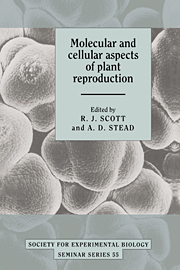Book contents
- Frontmatter
- Contents
- List of Contributors
- Introduction: ‘Where do we go from here?’
- Molecular control of floral organogenesis and plant reproduction in Petunia hybrida
- Control of floral morphogenesis in cauliflower (Brassica oleracea L. var. botrytis): the role of homeotic genes
- Isolation and properties of mutants of Arabidopsis thaliana with reduced sensitivity to short days
- Asexual mutants in Melandrium album (Silene alba): tools in cDNA cloning and analysis of an X/Y chromosome system in plants
- Pollen exine – the sporopollenin enigma and the physics of pattern
- The diversity and regulation of gene expression in the pathway of male gametophyte development
- Characterisation of Arabidopsis thaliana anther-specific gene which shares sequence similarity with β-1,3-glucanases
- Ovule cDNA clones of Petunia hybrida encoding proteins homologous to MAP and shaggy/zeste-white 3 protein kinases
- Towards the elucidation of the mechanisms of pollen tube inhibition during the self-incompatibility response in Papaver rhoeas
- Intracellular movement and pollen physiology: progress and prospects
- Organisation and functions of cell surface molecules on gametes of the brown algae Fucus
- Strategies of flower senescence – a review
- The physiology of petal senescence which is not initiated by ethylene
- Molecular biology of flower senescence in carnation
- Ethylene sensitivity and flower senescence
- Ethylene biosynthetic genes and inter-organ signalling during flower senescence
- Index
Towards the elucidation of the mechanisms of pollen tube inhibition during the self-incompatibility response in Papaver rhoeas
Published online by Cambridge University Press: 04 August 2010
- Frontmatter
- Contents
- List of Contributors
- Introduction: ‘Where do we go from here?’
- Molecular control of floral organogenesis and plant reproduction in Petunia hybrida
- Control of floral morphogenesis in cauliflower (Brassica oleracea L. var. botrytis): the role of homeotic genes
- Isolation and properties of mutants of Arabidopsis thaliana with reduced sensitivity to short days
- Asexual mutants in Melandrium album (Silene alba): tools in cDNA cloning and analysis of an X/Y chromosome system in plants
- Pollen exine – the sporopollenin enigma and the physics of pattern
- The diversity and regulation of gene expression in the pathway of male gametophyte development
- Characterisation of Arabidopsis thaliana anther-specific gene which shares sequence similarity with β-1,3-glucanases
- Ovule cDNA clones of Petunia hybrida encoding proteins homologous to MAP and shaggy/zeste-white 3 protein kinases
- Towards the elucidation of the mechanisms of pollen tube inhibition during the self-incompatibility response in Papaver rhoeas
- Intracellular movement and pollen physiology: progress and prospects
- Organisation and functions of cell surface molecules on gametes of the brown algae Fucus
- Strategies of flower senescence – a review
- The physiology of petal senescence which is not initiated by ethylene
- Molecular biology of flower senescence in carnation
- Ethylene sensitivity and flower senescence
- Ethylene biosynthetic genes and inter-organ signalling during flower senescence
- Index
Summary
Introduction
Self-incompatibility (SI) is the single most important outbreeding device found in Angiosperms. It is a mechanism under genetic control which regulates the acceptance or rejection of pollen during fertilisation. In many species SI is controlled by a single, multi-allelic (S-) gene (Darlington & Mather, 1949; de Nettancourt, 1977). Self-fertilisation is prevented when pollen carrying an S-allele which is genetically identical to that carried by the stigma on which it lands is discriminated from pollen carrying an S-allele which is not carried by the stigma; the former is inhibited, whereas the latter grows normally to achieve fertilisation. As such, self-incompatibility systems play a fundamental and crucial role in the processes involved in Angiosperm sexual reproduction.
SI systems may be conveniently divided into two groups: one is under sporophytic control; the other, which appears to be much more wide-spread, is under gametophytic control. Over the last ten years there has been considerable accumulation of new information, revealing much about the molecular and cellular processes involved in the two major SI systems. Most of the work on SI has concentrated on Brassica (which is under sporophytic control) and Nicotiana, together with other Solanaceous species (which are under gametophytic control). We are primarily interested in the SI system of Papaver rhoeas, which is determined by a single, multi-allelic gametophytically controlled S-gene (Lawrence, Afzal & Kenrick, 1978). In recent years we have begun to dissect the molecular events involved in SI in Papaver rhoeas.
- Type
- Chapter
- Information
- Molecular and Cellular Aspects of Plant Reproduction , pp. 173 - 190Publisher: Cambridge University PressPrint publication year: 1994



